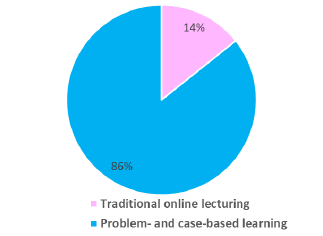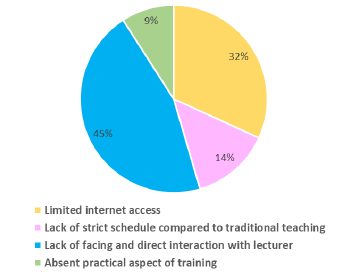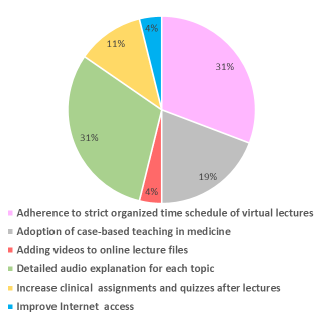Abstract
Background: Once Iraqi ministry of Health had declared cases of COVID-19 in Iraq with subsequent curfew announcement, both academics and students knew that this represented a curving point in educational process. Education in general and medical education have witnessed unprecedented changes that call for extra-ordinary measures. Despite crucial role of E-learning in bridging this period, it still has certain disadvantages especially for medical students who need the most the practical part of education and training in hospitals which is considered now forbidden considering pandemic spread.
Aim: This snapshot survey aimed to determine the preferred mode of teaching of medical students: problem-based and case-based learning (PBL/CBL) versus online traditional lecturing and to determine the fragile points in virtual learning from medical students’ perspective with exploring their suggestions for further improvement of this experience.
Methods: A cross sectional survey involving fourth year medical students attending the course of internal medicine, survey was sent via google classroom platform, the survey compared traditional online lecturing (explaining lecture topics in traditional methods by online lectures) versus problem-based learning (fragmenting the topics into clinical scenarios and clinical problems then ask students to solve the problems or suggest a clinical diagnosis accordingly), the survey also investigated main obstacles perceived by students in E-learning as well as proposed suggestions to overcome these obstacles.
Results: The survey was sent to 61 students, among whom 21 (34.42%) responded, 52.4% were females, 86% of students favour problem- and case-based learning in medical E-learning, while 14% favour traditional online lectures. Lack of direct facing and interaction with lecturer was the main obstacle faced by students (45%), while 32% reported limited internet access, 14% reported lack of strict time schedules of E-learning compared to traditional class teaching, 31% of students suggested adherence to stricter time schedule in online lectures can improve the teaching process, while 19% of them suggested adopting case-based teaching in medicine can remarkably bridge the gaps in medical E-learning.
Conclusions: Most medical students favour problem- and case-based learning approach as they can bridge the gaps in their practical teaching that resulted from stopping the clinical attachment in the hospitals during pandemic. Every effort should be made by decision makers to improve this experience by providing sustainable infrastructure for virtual learning and tracking continuous feedbacks from students to push the educational process wheel forward.
Keywords: Pandemic; Problem-based learning; Case-based learning; Medical education
Introduction
On February 24, 2020, Iraqi Ministry of Health declared first confirmed case of COVID-19 in Najaf governorate [1], with escalating number of diagnosed COVID-19 cases in other governorates, the government responded by implementing lockdown policy and announcing the curfew starting from March 17,2020 [2]. It is only then when the main educational polars; academics and students; knew that this pandemic represented a curving point in the educational process. In Iraq, not only the postgraduate clinical training was affected by the pandemic [3] but also the undergraduate medical teaching and training. Globally not only nationally, but education was also saved by implementing E-learning in universities, however, despite the crucial role of virtual learning in bridging this period, it still has certain disadvantages especially for medical students who need the most the practical part of education in hospitals which is considered now forbidden considering pandemic spread. Earlier studies during pandemic showed that medical students favour traditional class teaching [4] and prefer to return to clinical setting in learning as they feel that this is part of their professional responsibilities and to upgrade their clinical capabilities [5]. Education in general and medical education have witnessed unprecedented changes which call for extra-ordinary measures among which is relying on problem- and case-based learning (PBL/CBL) in teaching medical students, which means applying basic science and medical knowledge concepts to clinical scenarios and relevant clinical problems to be solved by the students [6]. During this global crisis we need to determine the best teaching approach to make medical education more enjoyable and well clarified.
Aim: This snapshot study aimed to determine the preferred mode of teaching of medical students (PBL/CBL versus online traditional lecturing) and to determine the fragile points in virtual learning from medical students’ perspective with exploring their suggestions for further improvement of this experience.
Methods: This is a snapshot cross sectional survey involving fourth year medical students who were attending the online curricular internal medicine course/ Al-Kindy College of Medicine/ University of Baghdad as part of continuing education in form of E-learning during COVID-19 pandemic. The survey was sent via google classroom platform to all students assigned within the course (n.=61). The survey included the following:
a) Ask the students to show which mode of E-learning they prefer; traditional online lecturing (Presenting topics in traditional methods by online lectures explaining basic knowledge of the topics) versus problem- and case-based learning (which means fragmenting the curricular topics into clinical scenarios and clinical problems then ask students to solve the problems or suggest a clinical diagnosis accordingly).
b) Investigated main perceived obstacles in their E-learning experience.
c) Ask students to propose suggestions to overcome these obstacles.
Data were presented as frequency and percentages of students approved each response.
Results
Twenty-one students responded to the survey (34.42%) among whom 52.38% were females. Eighteen students (85%) prefer PBL/ CBL over traditional online lecturing, while 3 students (14%) prefer traditional online lecturing, Figure 1. Lack of direct facing and interaction with lecturer was the main obstacle faced by students during their E-learning experience (45%), while 32% reported limited internet access, 14% reported lack of strict time schedules of E-learning compared to traditional class teaching, Figure 2. Students suggested several ways to improve their virtual education experience; mainly adherence to more strict timing schedule in online lecturing as same as was in the traditional in-class lecturing (31%), in addition to add audio explanation for each topic, so not relying only on PDF and PowerPoint uploading, nor on quizzes only as method of teaching. Furthermore, adoption of problem- and case-based learning method in teaching medicine was suggested by 19% of students, Figure 3.
Discussion
This snapshot survey disclosed preference of medical students to be taught by PBL/CBL instead of traditional lecturing when using E-learning and it revealed that the main barrier for E-learning were lack of direct interaction with lecturers, limited internet access as well as lack of strict online lecture time schedule. E-learning in Iraq does not have well established infrastructure nor well trained academic staff for this mode of learning. It is not surprising to know that Iraq was the last country in the Middle East to initiate E-learning system [7,8]. Many challenges are facing E-learning in Iraq like unclear plans, limited internet access, shortage of electricity, lack of funding, lack of professional technical staff as well as absent rigorous law regarding copyright protection [8]. In Iraq, 52.9% of Iraqi population were internet users as reported by end of March 2020 [9], additionally, we cannot ignore the cultural attitudes and traditional customs that are imposed on many female students by their families regarding access to information communication technologies, so it is expected that access to E-learning can be remarkably limited for many students. Despite all these barriers and amidst this unprecedented crisis E-learning is considered the last resort to continue education, this calls for taking steps forward to improve virtual education especially for medical students who were deprived from the clinical teaching in hospitals as a step to control pandemic spread. Accordingly, we suggest that PBL/CBL are crucial to be applied in E-learning and despite it cannot eliminate the necessity of clinical teaching in hospitals, but it can bridge a gap and focus on the necessary information that should be grasped by medical students. Taking in consideration the medical studentsꞌ eager for this mode of teaching, serious efforts should be taken to implement PBL/CBL in medical curriculum.
Absence of interactive lectures and lecturer-student facing is main reported disadvantage of E-learning in current study, prior researchers disclosed that E-learning can offer one way communication which resulted in under-development of communication skills of students, with lower verbal interaction and loss of the interaction between students (privileges that can be offered in traditional in-class teaching) resulting in depriving students from the multidimensional views of subjects and topics [10]. This can be relatively overcome by implementing live case discussions, assessments and questions, use clear interaction with continuous feedback provision, also effective monitoring of students’ progress can be useful [11]. As anticipated, medical students reported limited access to internet as other drawback of E-learning and this should call for better communication and feedback between Ministry of Higher Education and Ministry of Communications to overcome this major challenge in implementing E-learning in Iraq. Despite all reported barriers, E-learning still has many advantages including accessibility, adopting new technologies, and promoting independent and self-regulated learning, better control over educational content, learning sequence, pace of learning and time management [11,12] in addition to recall lectures when needed.
Conclusions and Future Directions
Most medical students favour problem- and case- based approaches as they can bridge the gaps in their practical training that resulted from stopping the clinical attachment in hospitals during pandemic. With medical education reshaped its landscape during pandemic, every effort should be made by decision makers to improve this experience by providing at least acceptable and sustainable infrastructure for E-learning, prepare well trained technical support teams, along with tracking continuous feedbacks from students to push the educational process wheel forward.
Acknowledgement
The author thanks all fourth year medical students at Al-Kindy College of Medicine/ University of Baghdad who participated in this survey.
Funding
None.
Conflict of Interests
None to be declared.
References
- (2020) Novel Coronavirus (COVID-19): Update from Iraq’s Ministry of Health.
- (2020) COVID-19: Iraqi government announces new measures.
- Farhan H, Dakhil Z (2020) TCT CONNECT-224 Interventional Cardiology Fellowship Training During COVID-19 Pandemic: Facts and Challenges. Journal of the American College of Cardiology 76(17 Supplement S): B97-98.
- Abbasi S, Ayoob T, Malik A, Memon SI (2020) Perceptions of students regarding E-learning during Covid-19 at a private medical college. Pakistan Journal of Medical Sciences 36(COVID19-S4).
- Compton S, Sarraf‐Yazdi S, Rustandy F, Kumar Radha Krishna L (2020) Medical students’ preference for returning to the clinical setting during the COVID‐19 pandemic. Medical Education 54(10): 943-950.
- Chang BJ (2016) Problem-based learning in medical school: A student's perspective. Annals of Medicine and Surgery 12: 88-89.
- Matar N (2011) E-Learning acceptance and challenges in the Arab region. In ICT acceptance, investment and organization: Cultural practices and values in the Arab world pp. 184-200.
- Al-Azawei A, Parslow P, Lundqvist K (2016) Barriers and opportunities of e-learning implementation in Iraq: A case of public universities. The International Review of Research in Open and Distributed Learning 17(5).
- (2021) Internet World Stats. Internet usage in the Middle East.
- (2018) UK Essays. Disadvantages of Online Learning Education Essay.
- Roddy C, Amiet DL, Chung J, Holt C, Shaw L, et al. (2017) Applying best practice online learning, teaching, and support to intensive online environments: An integrative review. In Frontiers in Education 2: 59.
- Ruiz JG, Mintzer MJ, Leipzig RM (2006) The impact of e-learning in medical education. Academic medicine 81(3): 207-212.

 Research Article
Research Article


